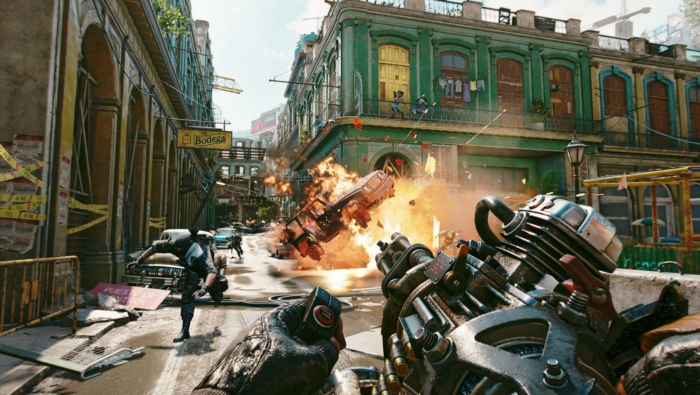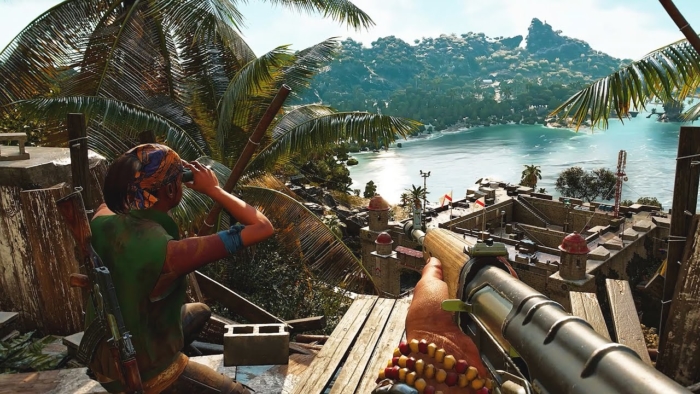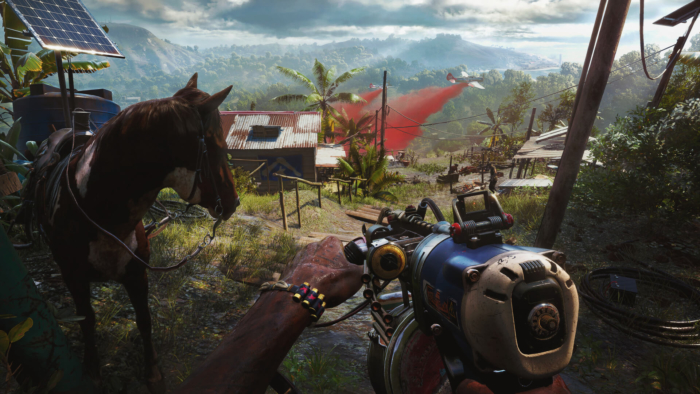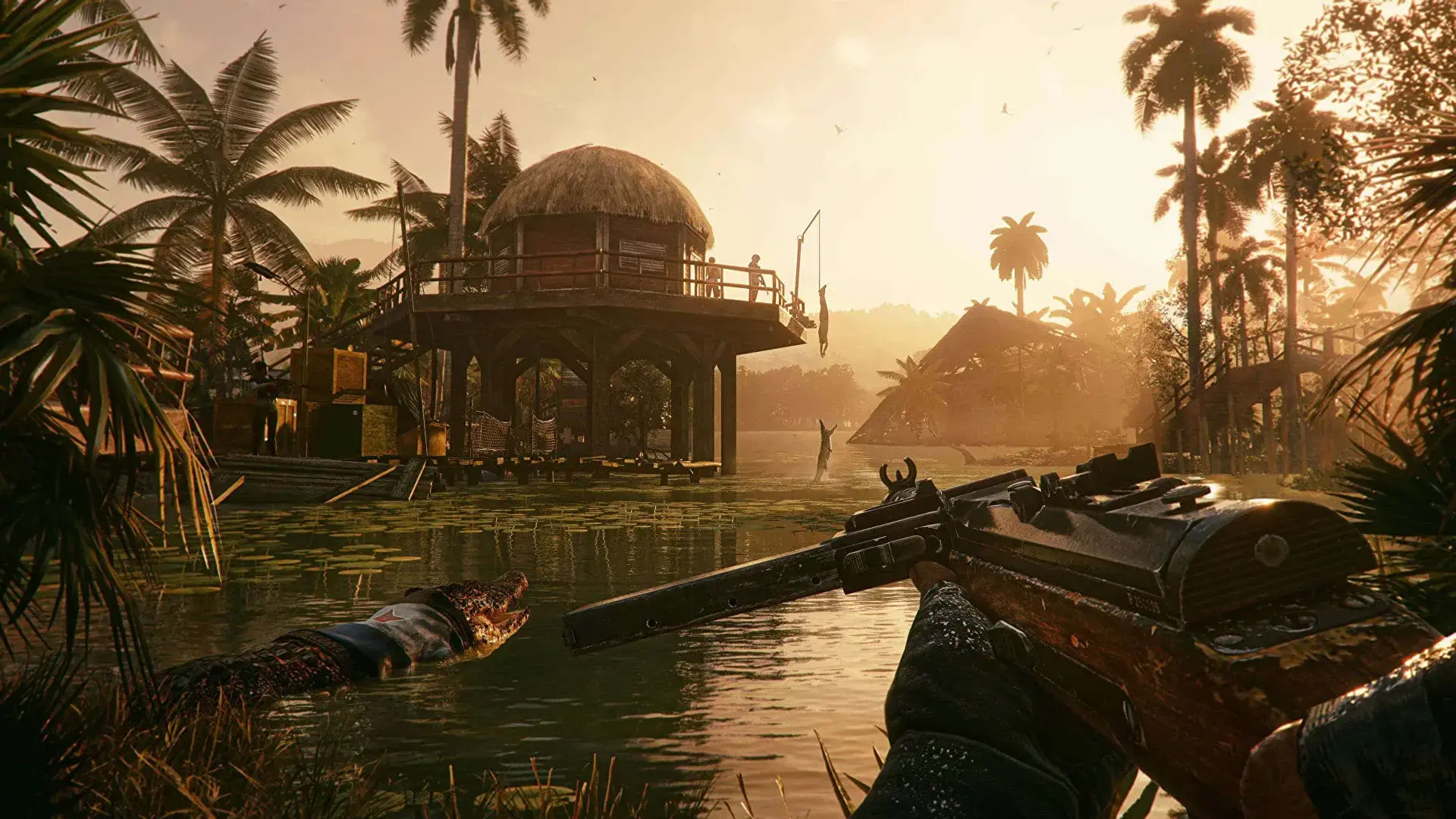Far Cry 6 (PS5 Review)
-
Gorgeous graphics and environment, fantastic soundtrack
-
Plenty of content
-
Some great moments
-
Lack of a self-improvement system can make the game tedious
-
Subpar story and gunplay
-
Bizarrely restrictive
Ubisoft’s FPS/RPG hybrid returns with a new tropical setting that’s clearly an analogue of Cuba (with some Haiti thrown in for good measure). As Dani, players will take part in a revolution to overthrow a dictator by slowly acquiring new weapons, allies, and slowly taking back your island.

Enjoying the Little Things
In the spirit of full disclosure, allow me to start this by saying that I consider myself a fan of the Far Cry series. I was initially ecstatic at the prospect of a new Far Cry, especially one with a setting similar to that of my personal favourite entry, Far Cry 3.
First, the good. Far Cry 6 is an absolutely gorgeous game. The lighting system is fantastic, the setting is beautiful, and there are lots of great little details — my favourite of which is definitely how the main character will occasionally sing along to the radio while driving. There’s some good exploration and the quality of the side quests probably averages out to be the best they’ve ever been in a Far Cry game, although, said quality is extremely uneven. A crafting and weapon improvement system expanded upon from Far Cry 5 makes exploration feel rewarding: even if you don’t find any new weapons or secrets in a location, you’ll still find a few scraps to build a new scope or give your gun a special effect. Most story mission chains will end with a big set-piece, which were generally fun and memorable. And, like all Ubisoft games, there’s no shortage of things to do, for better or worse.
A Story Full of (Bullet) Holes
The game begins with a stunning cinematic showing the history of the Cuba-inspired nation of Yara: Conquistadors committing genocide, oppression by a wealthy upper class, bloody revolution. This montage of colonialism is about as deep as the politics of the game go, however. Looking to Far Cry for political nuance is like looking to the UFC for insight on Finnegans Wake, but I still found the inanity of the game’s politics vaguely insulting. It uses politics as set dressing, nothing more, and it’s all carefully calculated to offend no one.
Main antagonist Antón Castillo is played by Giancarlo Esposito (Breaking Bad, The Mandalorian) with a suitable air of menace. Although he has all the trappings of a good villain, he only very briefly directly opposes the player. He’ll primarily be seen in vignettes between missions, where he’ll show up to do some moustache-twirling that’s largely unrelated to the main narrative thrust of the game. He feels less like a villain than a symbol of a villain.
Paradise Lost
The worst sins of Far Cry 6, by far, are the absolutely baffling changes that have been made to the series formula. The traditional level-up-choose-a-skill progression system has been eschewed entirely in favour of a system where your skills are determined by the clothes you wear, somewhat like late-game Destiny. This means that, at any given time, you can only have five skills equipped (hat, chest, hands, trousers, and shoes). Much of the clothing is completely useless: why would you wear something that takes up a precious equipment slot for a piece of gear that, and this is real, “improves fire resistance after sliding?” That’s about as useful as a fireproof candle. You won’t be unlocking any game-changing abilities: instead of unlocking cool new skills, you’ll instead get things like marginal reload speed increases or slightly quieter move speed. You’ll never feel your character is growing stronger.
Removing the level-up system has two major implications on gameplay. First, there’s no longer a feeling of improving and growing stronger. Your options will mostly be the same from the beginning of the game to the end. Not only that, but much late-game equipment comes with a drawback — such as increasing one type of damage resistance while lowering another, or increasing damage output but slowing movement speed. The game lacks the promise of character improvement, and frankly, the game’s story isn’t good enough on its own to compel players through the enormous amount of content Far Cry 6 provides.

The second major implication of the lack of a level-up system is that player versatility has been dramatically reduced. Part of the appeal of the Far Cry series, to me, has always been the ability to swap tactics on the fly. Start with a stealth bow and arrow approach, switch to heavy explosives when the alarm sounds, then use a vehicle when things get too hairy. Not so in Far Cry 6. Theoretically one can change their outfit mid-battle, but I found that completely ruined the momentum of the game. The player is clearly encouraged to make a watered-down build and stick with it. Not only that but vehicles have been given what feels like an extreme nerf from previous games: helicopters now feel like their armour is made of tissue paper and their guns fire “Silly Bullets™, the world’s first safety bullets for kids®“!. This leaves the player with even fewer viable playstyles.
You’re No Fun Anymore
Far Cry 6 introduces a wanted system somewhat like that of the Grand Theft Auto franchise, except way more obnoxious. Cause too much chaos and special forces will spawn in and hunt you down. Enemy spawn rates are so incredibly busted, however, that almost any non-scripted encounter ends with hordes upon hordes of enemies spawning more quickly than you can kill them, inevitably ending with a clash with the special forces. It seemed that using explosives or destroying enemy vehicles caused the wanted level to rise faster, which leads me to this question: why does the game punish fun? The wanted system can be eliminated in a region after that region’s base has been captured, but why have it at all? Feeling like a ridiculous 80s action hero blowing things up left and right has always been part of the Far Cry ethos, but now the game seems hellbent on making sure the player never has too much fun or feels too strong.
In a series that, admittedly has its share of flaws, why did they try and fix what actually worked? Like all Far Cry titles, the gunplay lacks the snappiness and responsiveness of a top tier FPS, enemies will kill you with perfect accuracy at incredible distances and through foliage where you can’t see them, and many of the characters feel paper-thin. And, this being Ubisoft, you will be bombarded with advertisements for microtransactions and DLC at every turn. None of these issues have been addressed: instead, player progression has been hobbled, and destruction discouraged, in a series that has always been, at least in part, a power fantasy.

I struggle to understand this change, and then it hit me: Far Cry 6 is the first step in transforming the series from a single-player experience into a multiplayer one. It’s balanced as a multiplayer game. Consider how in Far Cry 5 certain skills were disabled when you entered co-op play: one can’t help but wonder if the elimination of the skill system was to circumvent a similar situation. Players can only have so many skills equipped to encourage each player to fill a role, like in Fallout 76. There’s even a new Overwatch-esque ult mechanic. The easiest way to farm materials is by doing daily online co-op missions. I wouldn’t be surprised at all if the next game in the series was multiplayer only. I’m the type of misanthrope who uses the self-checkout counter at all costs, so this absolutely sucks.
Ultimately, Far Cry 6 is an expression of a series that has begun to misunderstand itself. So much of what makes Far Cry great has been stripped from the game. The supernatural elements have been toned way down, there’s virtually no trippy psychedelia, no morally grey reflection on violence. A ragtag group of misfits band together to take down an evil ruler — hardly a groundbreaking plot for a video game. The weirdness is gone, the enduring rough edges have been sanded down to dullness, and, quite simply, the fun has been intentionally hampered for the benefit of an online experience whether you choose to engage with it or not.
The closest this game comes to previous entries are the recycled animations.

